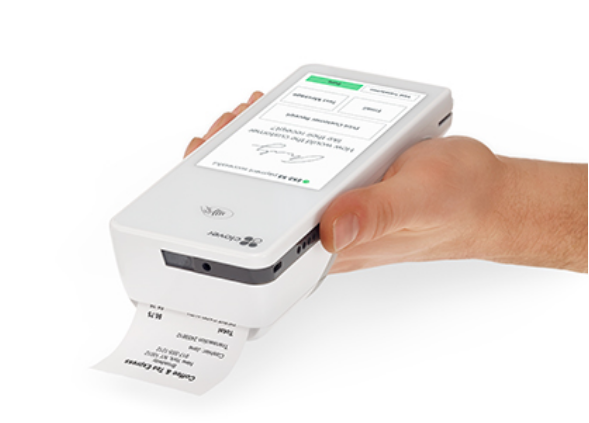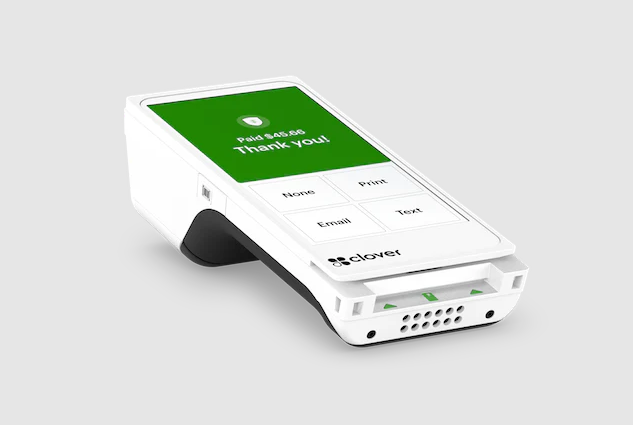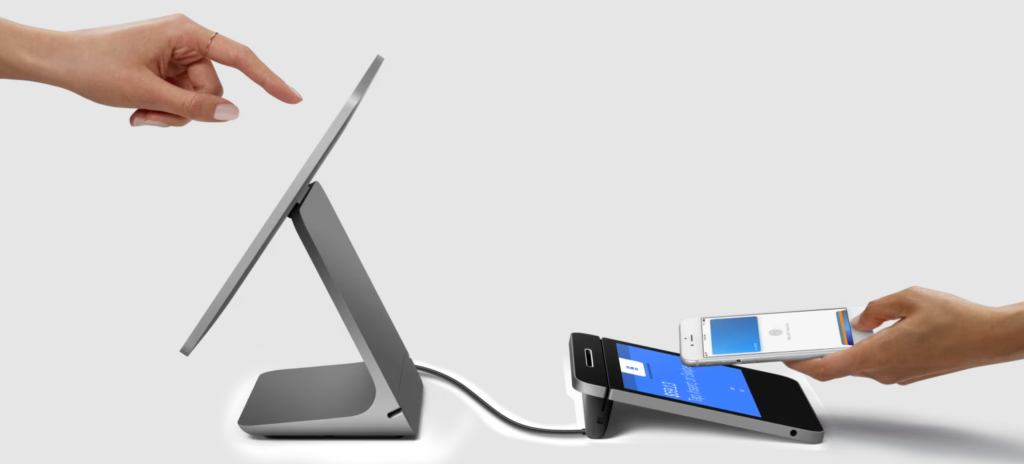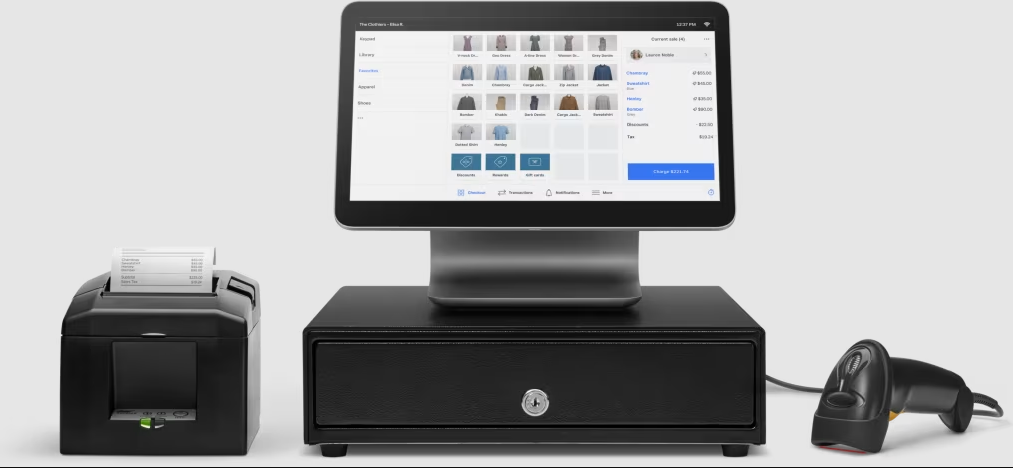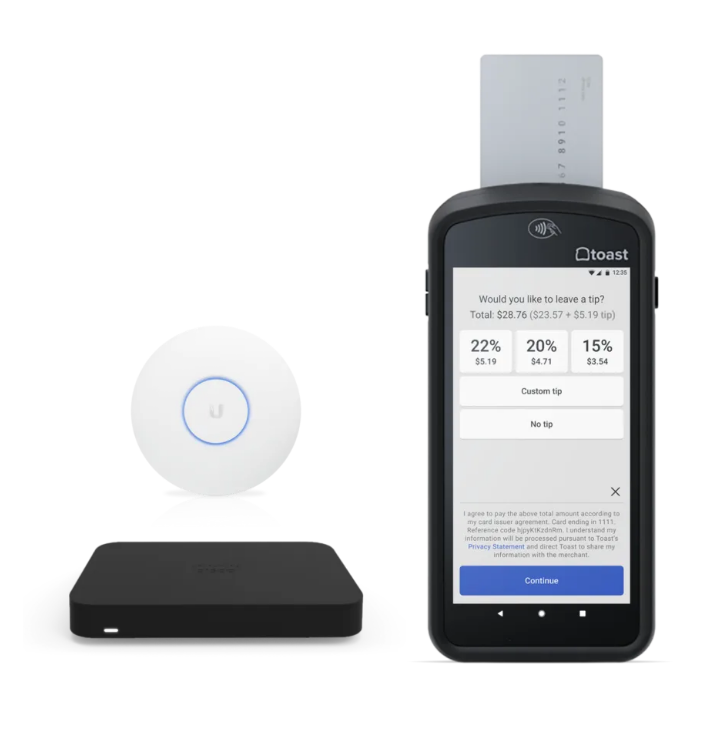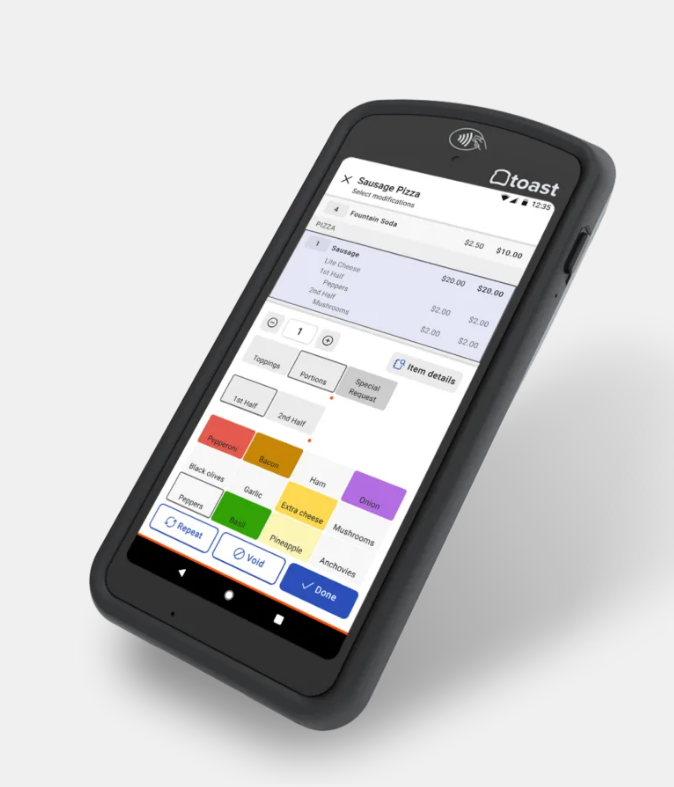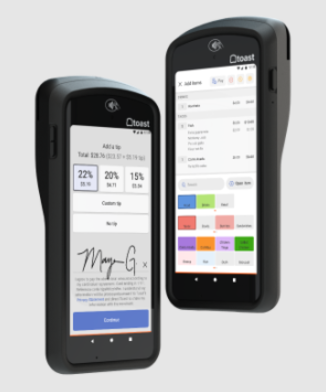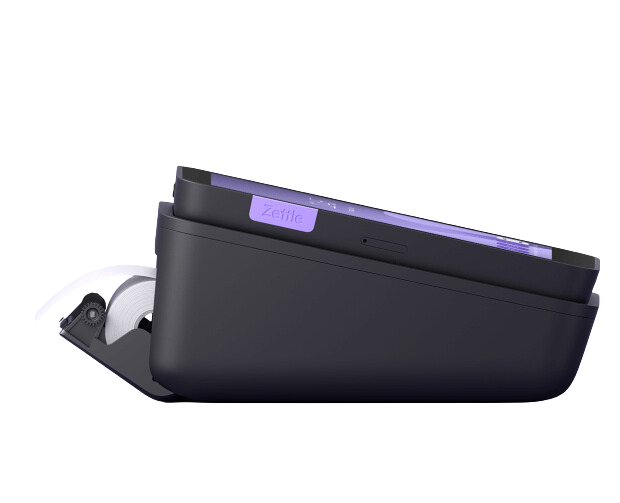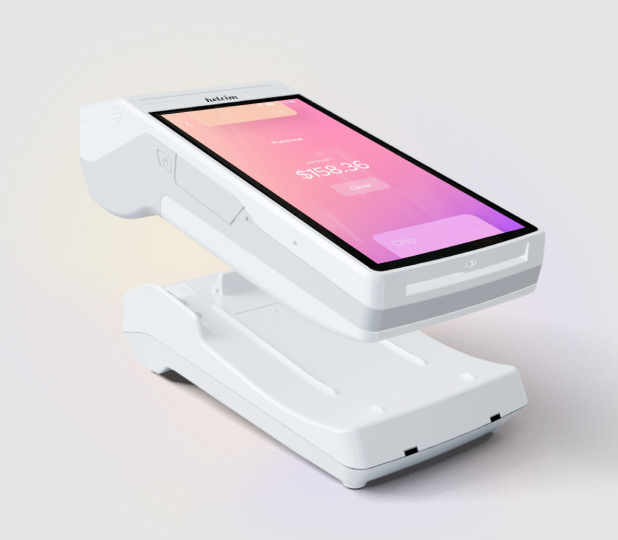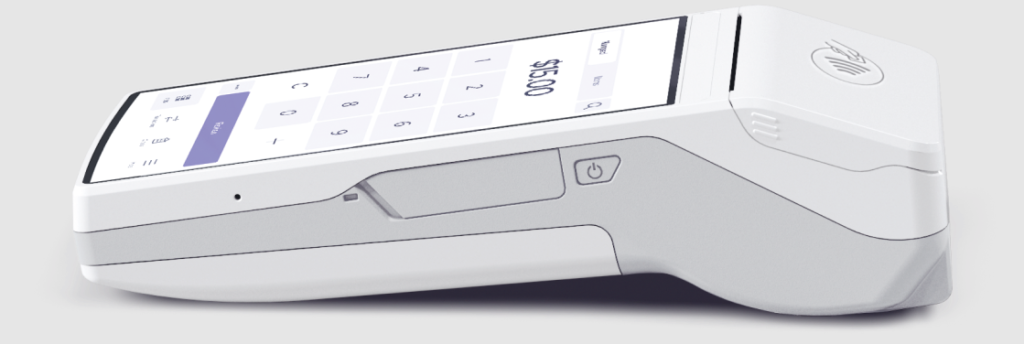Best POS Hardware for Businesses
Using your mobile phone or an iPad as point-of-sale (POS) hardware can be convenient, but it might not be the ideal situation for some businesses. Choosing the best POS hardware comes down to finding the right pieces for your needs, whether you work in a busy restaurant, a brick-and-mortar retail shop, or pop-up shops in multiple towns. After carefully considering features, durability, and pricing, we picked the best POS hardware for various small businesses.
Clover Flex: Best overall Square Register: Best for retail Toast Go: Best for restaurants PayPal Zettle Terminal: Best for alternative payments Helcim Terminal: Best all-in-one device
We started with more than a dozen credit card readers and POS hardware options to consider for this list. While pricing and payment processing are important factors, we focused on hardware features to ensure our choices make the most sense for your business. For example, durability is vital for busy restaurants and battery life is important for mobile businesses that sell at markets away from outlets.
Factors such as warranties, screen size, and receipt printing options were considered and make up 30% of the score. Payment processing options such as types of payment you can accept, how quickly you can make transactions, and whether you can choose your payment processor were all taken into account for 20% of the total score.
All small businesses are concerned with the bottom line, which is why we also considered overall cost. In some cases, hardware is free with a new account, so we marked that. However, we recognize that some of the best POS hardware may come with an upfront investment that’s worth the cost, so we didn’t penalize too much. We also looked at pricing structure because flat-rate costs may be better for new businesses, but interchange-plus typically works better for established companies. The weight for this category is 20%.
We awarded 15% each to additional features and user experience. These categories can’t be scored by simply reading the manual, so to speak. When possible, we test the products we review to be able to relate the ease of use, reliability, and speed. We also consider how other users rate the POS hardware we’re reviewing.
Best POS hardware at a glance
Our score
Hardware type
Cost
*Interest-free monthly installment plans available
**As part of a Starter Kit, which also includes a data security router and wireless access point. Also available for $0 upfront with a pay-as-you-go pricing plan
Related: What is a POS system?

Clover Flex
Overall Score
4.62/5
Hardware features
4.86/5
Payment processing
4.69/5
Pricing
4/5
Other features
4.69/5
User experience
4.88/5
Pros
- Choice of monthly or upfront price
- Built-in barcode scanner
- Includes integrated receipt printer
- Card and contactless payments allowed
- Portable POS hardware solution
- Inventory management included
- Full reporting options
- WiFi connectivity
Cons
- Only connects via WiFi or LTE
- Requires you use its payment processor
- 36-month contract required
- Some software features only on high-tier plans
Why I chose Clover Flex
Clover Flex checks most of the boxes to earn it the title of the best POS hardware around. To start, it’s a handheld device with a nearly 6-inch touchscreen that’s easy to use. It includes a built-in receipt printer, or you can deliver a digital receipt if customers prefer. There’s also a barcode scanner to make it easy for retailers to tally up purchases. The battery life averages eight hours, which is standard for most mobile POS systems. I like that you can use it anywhere to take orders, ring up sales, and take payments.
The Clover Flex is durable, but you may want to add Clover Care, an extended protection plan, to replace any broken devices as needed. It’s a three-year warranty, so it’s conveniently within the same window of your 36-month plan. Take note that you can only replace up to three devices during the term.
In several user reviews, ease of use is the highest praise for Clover Flex. The device is intuitive and requires little training, which is good because many users also mention Clover’s support as less helpful than they’d like. Though if you need help learning how to use a POS system, there are guides that can teach you the basics.
As far as pricing goes, Clover Flex is pricier than the Zettle Terminal and Helcim Terminal, but it’s on par with Square Register and Toast Go. You can choose to pay $599 upfront for the device or $35 per month (with a 36-month contract). Of course, there’s more than the upfront payments for POS hardware, as POS system costs include payment processing. You also have to opt for Clover’s flat-rate payment processing, which offers competitive rates with other flat-rate processors such as Square (expect 2.5% + 10 cents to 3.5% + 10 cents per transaction). Payment processing and POS software pricing ranges from $14.95 per month to $84.95 per month, excluding transaction fees and hardware fees.
Accepts most payments
Chip, swipe, and NFC payments
Payment processing
Multiple plan options for different types of businesses; required contract for payment processing and POS hardware
Touchscreen
5.99” LCD color touch screen (720 x 1440 px)
Connectivity
WiFi and cellular
Battery Life
8 hours
Built-in features
Thermal dot printer for receipts; barcode scanner and camera

Square Register
Overall Score
4.61/5
Hardware features
5/5
Payment processing
4.38/5
Pricing
3.75/5
Other features
5/5
User experience
4.92/5
Pros
- Sleekly designed register for countertops
- Easy-to-use touchscreens on both displays
- One-time fee or installment plan for purchasing hardware
- Includes free POS software
- Competitive flat-rate payment processing
Cons
- Requires you to use Square as your processor
- Expensive hardware with no built-in extras
- Not a portable POS
Why I chose Square Register
Square is well known for its POS software, specifically its free POS plan. Square is also a popular choice among retailers for its hardware because it’s easy to use, but there are more reasons why we chose Square as the best retail POS system. I’ve always been a fan of Square for that same reason; I’ve used it as a merchant and customer and I like how simple it is to use the components and the software. Though I’m more familiar with its small square card reader, I can see why it’s often named the best mobile POS system.
The Square Register is especially useful for brick-and-mortar stores that intend to have a stationary register. The standard setup is sleek, with a display for you and one for customers. Both are touchscreens connected by a 3-foot cable, which allows you to extend the customer display farther away from the register, should you choose to do so. The register display is a decent size at 12.5 inches by 10 inches, while the customer display is smaller at 6.85 inches by 6.85 inches.
Square offers a two-year limited warranty, which is nice for peace of mind. For two years, you’re protected from defective hardware, so you can get a replacement at no extra cost. It would’ve been nice if Square offered more built-in hardware accessories, but I like that you can add third-party components.
Square Register is expensive at $799 or $39 per month through an installment plan. Plus, it doesn’t include peripherals that you may consider necessary such as a receipt printer or barcode scanner. If you choose additional hardware to make it a complete setup, you’re looking at $1,899. While pricey, the monthly fee ranges from free to $29 per month, plus flat-rate transaction fees that are reasonable, ranging from 2.6% plus 10 cents per transaction to 3.5% plus 15 cents per transaction. The only caveat: You have to use Square as your processor.
Accept most payments
Square Register allows you to accept credit, debit, and contactless payments
Long warranty
A two-year warranty protects you from defective Square Registers
Connectivity
WiFi and Bluetooth (though the register must be plugged in)
Hardware peripheral choices
You can choose from several receipt printers, barcode scanners, cash drawers, scales, and stands
Easy-to-use register
The main display measures 13.25 inches diagonally and the customer display measures 7 inches from corner to corner, which is both generous for viewing but minimal in its counter footprint
Both displays are touchscreens, so there are no extra components requiring you to key in anything; simply tap what you want on the screens
Optional free POS plan
Square offers a free POS plan which is suitable for new businesses, but you may want to choose a plan with a monthly fee for lower transaction fees and more software features

Toast Go 2
Overall Score
4.3/5
Hardware features
4.58/5
Payment processing
4.38/5
Pricing
3/5
Other features
4.69/5
User experience
4.85/5
Pros
- Designed to be drop-proof and water, dust resistant
- Offers pay-as-you-go plan with zero upfront cost
- Optional restaurant-related accessories available
- Lightweight handheld terminal
- Up to 24-hour battery life
Cons
- Expensive upfront investment
- Higher payment processing rates
- Must use Toast payment processing
Why I picked Vendor
The Toast Go 2 starter kit costs $799.20 if you choose traditional pricing. If you add on a payment processing and POS software plan, you’ll need to add $69, $219, or $579 per month to that. Alternatively, you could choose pay-as-you-go pricing, which means you pay nothing upfront, rather you pay higher transaction fees. For traditional pricing, the transaction fee is 2.49% plus 15 cents per charge, and with the “free” plan, you’ll pay 3.09% plus 15 cents per charge.
Accept most payments
Credit, debit, and contactless payments
Weight and dimensions
Weighs 1.13 lbs.; 7.87” L x 3.74” H
Battery life
Up to 24 hours; charges in 4.5 hours
Durability
Designed to be drop-proof up to 4 feet; dust and water-resistant
Hardware accessories
Toast also offers kitchen display systems (KDS), label printers, kitchen printers, receipt printers, and cash drawers
Warranty
One-year limited warranty that covers defects

Zettle Terminal
Overall Score
4.2/5
Hardware features
4.86/5
Payment processing
4.38/5
Pricing
4/5
Other features
3.44/5
User experience
4.35/5
Pros
- Accepts alternative payments (PayPal, Venmo)
- Affordable hardware costs
- Competitive transaction fees
- Optional terminal with built-in barcode scanner
- Hardware peripherals available
Cons
- Requires you use PayPal payment processing
- No third-party barcode scanners compatible
- High transaction fees for alternative payments
Why I chose Zettle Terminal
PayPal’s Zettle Terminal is an example of how you can set yourself apart from the competition, and in Zettle’s case, it accepts payments most other POS hardware and payment processors don’t. Your customers can pay via credit or debit card, Apple Pay or Google Pay, or they can pay using their PayPal or Venmo accounts. I can’t tell you how many times I wish I could use alternative payments; if it were more common, I might leave funds in my PayPal and Venmo accounts.
The alternative payment option isn’t the only reason the Zettle Terminal makes this list of the best POS hardware. The handheld POS hardware is one of the lightest devices on the market, at less than one pound. It’s easy to use and can fit in a pocket. Its battery life isn’t as long-lasting as the Toast Go 2, but at 12 hours, it’s longer than the Clover Flex.
You can choose the standard POS Zettle Terminal, which includes POS software and payment processing, or you can opt for the model with a built-in barcode scanner. There’s a one-year limited warranty that protects against defects, which is standard for the industry.
Here’s where things get even better for the Zettle Terminal. As far as hardware goes, this is one of the most affordable handheld POS hardware available. Upfront costs are $199 or $239 with the built-in scanner. An optional add-on is the receipt printer and docking station that can charge your devices, which only costs $99, and the bundle includes five rolls of printer paper which are usually sold separately, such as for Square’s printers.
Now, here’s the caveat: You have to use PayPal’s payment processing. The good news is that PayPal’s transaction fees are surprisingly competitive. Card-present fees cost you 2.29% plus .09 cents per transaction, which is lower than most flat-fee processing fees. Manual entries cost 3.49% plus .09 cents per charge, which is still a bit lower than other processors. Alternative payments cost a bit more at 2.99% plus 0.49 cents per transaction, but given that this is an option at all, I don’t see this as a negative.
Accepts more payments
Credit, debit, contactless, and alternative payments, including PayPal and Venmo payments
Connectivity
WiFi and cellular
Weight and dimensions
Less than .5 lbs.; 5.4” L by
Battery life
12 hours; 48 hours when not in use
Built-in tools
Optional POS terminal with a built-in barcode scanner
Hardware accessories
Printer and dock; dock can serve as a charging station for a handheld POS terminal

Helcim Terminal
Overall Score
4.16/5
Hardware features
4.86/5
Payment processing
4.06/5
Pricing
4/5
Other features
3.13/5
User experience
4.73/5
Pros
- Interchange-plus pricing structure
- Portable POS with printer
- Affordable device
- Option to pay upfront or in installments
Cons
- Better for established businesses
- No barcode scanner add-on
- Requires Helcim payment processing
Why I chose Helcim Terminal
Though there are several POS hardware options on the market, Helcim makes the cut on this list because it’s one of the few portable POS systems that’s a nearly complete all-in-one solution. In my opinion, the pros outweigh the cons over some other contenders we considered for this lineup of the best POS software. Namely, Helcim lets you accept most payments and print receipts all from a portable device; it even includes two rolls of printer paper. It isn’t the only all-in-one option available (the Clover Flex does all that and more), but it’s also affordable.
Helcim’s POS software includes features to help with inventory management and payment processing is built into the system. Its battery isn’t the longest life we’ve seen, but it is standard at eight hours even if you’re using the built-in printer. Charge time is about four hours to get the battery to full. Along with a WiFi connection, transaction speeds are fairly fast.
One of the main reasons Helcim’s Smart Terminal makes the cut is that it’s affordable, though not as cheap as the PayPal Zettle Terminal. You can pay for your POS hardware outright for $329, or choose to pay $30 per month over a year. Helcim is similar to the other POS systems we ranked here in that it requires you to use its payment processing, but it offers a flexible interchange-plus transaction rate.
If you bring in less than $55,000 per month in sales, you should expect to pay about 1.83% plus .08 cents per in-person transaction (1% plus .08 cents for debit). As you make more sales, your fees go down. For those with a monthly sales volume of $150,000, you can expect to pay approximately 1.68% plus .07 cents per in-person transaction. As much as I prefer these fees, it’s clear that this type of pricing structure is meant for established businesses, which is why I suggest flat-rate payment processing for startups that aren’t quite making as much in sales.
Accepts most payments
Credit, debit, and contactless payments
Connectivity
WiFi
Built-in tools
Receipt printer
Battery life
8 hours; 4 hours to charge
Key Components and Features of POS Hardware
There are many types of POS hardware you should consider adding to your POS system stack such as barcode scanners, kitchen display systems (KDS), receipt printers, and cash drawers. Most of these hardware components would be essentially useless without the core piece of any POS system: the terminal. It’s the terminal that includes key features that allow you to accept payments and track sales.
Here’s what you can usually do with POS terminals:
Accept payments: All POS hardware should be equipped to handle payments, whether by cash, card, or contactless payments. Some POS terminals have a built-in credit card reader, while others may require you to add one such as in the case of those who want to use tablets or mobile phones as their POS system.
Record sales: As you ring up sales, it’s important to keep track of those sales, along with returns, so you can calculate your profits and losses. Your POS terminal should have a place that records all transactions for the day.
Print receipts: Many POS terminals may include a built-in receipt printer or you can deliver a receipt digitally such as with Square Terminal, which offers both options. Receipts are vital for most businesses so customers can track their own spending or return an item.
Manage inventory: Not all POS hardware includes inventory management as a feature. This feature may be included in your POS software. Alternatively, you may need to invest in inventory management software separately and have it integrated into your POS system.
Run reports: Whether it’s sales reports, a P&L report, or even timesheets, POS hardware that includes a feature to generate reports is helpful. This may be part of your POS software, but some hardware offers reporting in its system.
Choosing the Right POS Hardware for Your Business
There are several POS hardware options that may work for your business, but to choose the best POS hardware, you should take many factors into consideration. The type of your business, connectivity needs, integration options, payments you want to take, and the durability of the POS hardware you choose are some of the factors.
Consider these needs before you sign a contract or shell out hundreds of dollars for your POS hardware:
Type of business
A mom-and-pop shop can get away with a simple POS system, but a busy restaurant is likely to need more technology to keep up with demand. Consider your sales volume and the type of device you want to use to accept payments. An iPad can work as a terminal if you plan to keep it at a counter, but if you’re mobile and dealing with slippery situations, you want a device that’s more durable.
Warranty
Clumsiness happens, so it’s important to consider the warranty of POS hardware. Dropping a tablet could mean expensive replacements. Even the most durable devices may break or have a glitch, which is why quality and length of warranty matter.
Connectivity
If you have reliable WiFi, most modern POS hardware should work well for you. Bluetooth could be a better option if you have a mobile business and need to rely on your cellular network. The more antiquated method of tethering requires you to be stationary, so it’s a better option for retail stores.
Payments accepted
You should expect all POS hardware to include the ability to accept payments by credit and debit cards. The best POS hardware also allows you to accept contactless payments such as by Apple Pay or Google Pay. There are a few that allow you to accept payment from popular cash apps, including Venmo and PayPal. Consider your customers and how they prefer to pay.
Payment processor
Many POS hardware companies include their own payment processing, which is part of the reason you may find free or cheap POS hardware available (they’ll make money on transaction costs). However, there are some that allow you to choose your own payment processor, which is great when you already have a good rate with a merchant services provider.
Contract type
To get hardware for your POS system, you may need to sign a contract either to lease the equipment or for your payment processor. Consider the terms carefully because some require you to sign up for at least a year, while others may only require month-to-month commitments.
Reliability
The POS system you choose is only as good as its reliability. Look for POS hardware companies that ensure good uptime for your payment processing. Keep in mind this isn’t just about the system; your internet provider may be at fault if you have disruptions.
Pricing
Though cost is always a factor for small business software, it isn’t the most important factor. There’s usually a balance you can strike depending on whether you use an all-in-one POS hardware, software, and payment processing system where you pay little to nothing for your equipment. Or pay more for equipment and use a payment processor that offers a better rate.
Training
Going from a pen-and-paper method to a complex system may require a bit of downtime for training. Consider what you and your team will need to adapt to new POS hardware and choose something that’s easy to learn and use or offers thorough training on the equipment and software.
FAQs
The terminal is the heart of any POS system. Other POS hardware helpful to have include a receipt printer, cash drawer, and a customer-facing payment screen. Many companies offer all-in-one terminals, which can be more economical for small businesses.
Yes, a laptop can be used as a POS system, just as a tablet or mobile phone.
In most cases, yes, though it mostly integrates with the POS software you’re using. This is an important consideration because you may need to connect your accounting, inventory, and payroll software to your POS system.
The post Best POS Hardware for Businesses appeared first on TechnologyAdvice.



